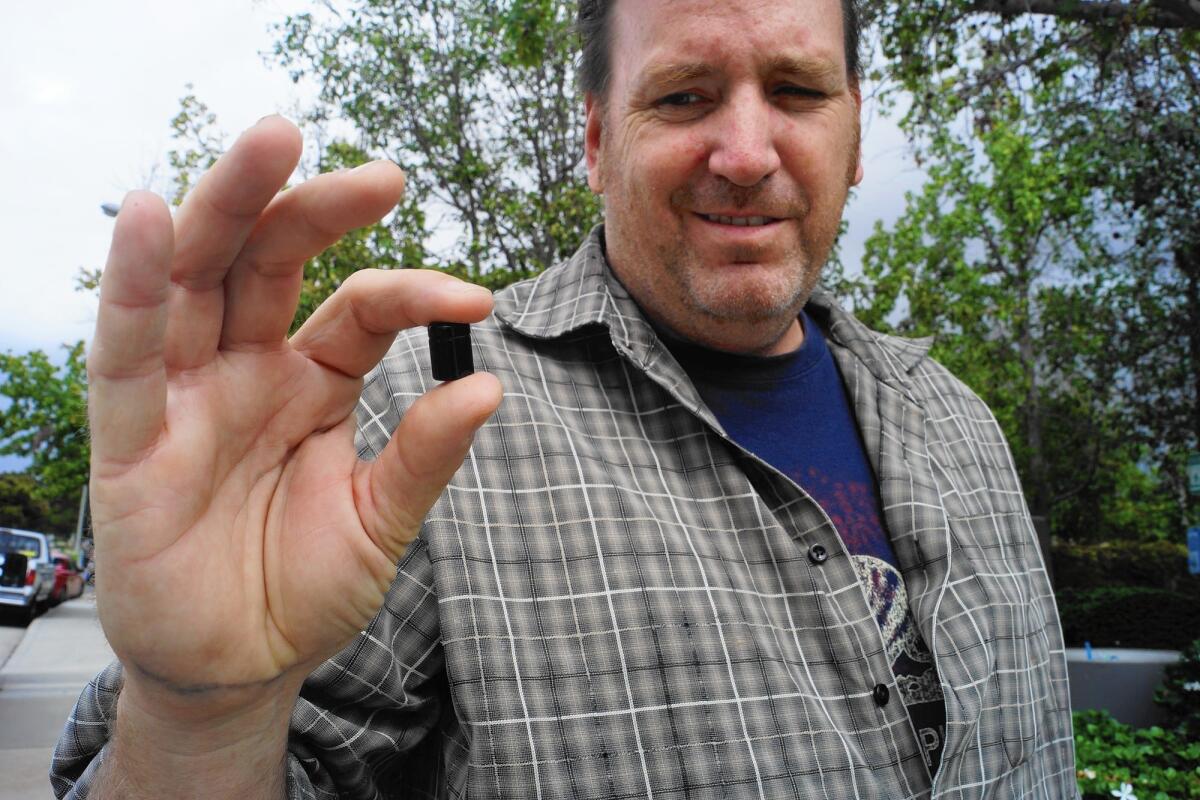Geocaching: A treasure hunt on a massive scale

The team laced up their hiking shoes and turned on their GPS devices. They had no idea what they were searching for, but they were hot on the trail of something.
They strode along a creek in Veeh Ranch Park in Laguna Hills, gently sifting through the branches and leaves on the ground.
“It might be under here,” one of them said.
Another teammate looked at her GPS. “It’s a little further up that way,” she said, pointing to a tree. The group of less than a dozen quickly moved.
Two people crouched down by the tree’s roots. They began to dig through the pile of leaves. One grabbed what felt like a handle. She pulled it up to find the handle attached to a container. “Found it!” she said.
These devoted searchers were involved in geocaching, an outdoor activity that involves tracking down “caches.”
The caches, or containers, are hidden or camouflaged. Once found, the cache is opened and the discoverer enters the date of his find and signs his code name on a piece of paper or a notebook left inside. This log is then returned to the container and the container placed back where it was found — for the next people to find it.
Caches come in different shapes and sizes — an Altoid box, a jar, even a bolt head.
If the cache is big enough, players may discover small objects inside, like coins or seashells. They can make a trade, replacing an object in the cache with another brought to the site.
Sometimes these items are moved from cache to cache and their travels logged.
Cachers can find mapping coordinates and clues to track down these treasures online, on a GPS or on the game’s smartphone app. The coordinates will lead players to a cache’s general location, but the challenge remains to find its exact whereabouts.
People all across the globe take part in the game, which is described as the world’s largest treasure hunt.
Today, Orange County has 5,538 active geocaches, and California contains the most geocaches of the states with 136,648, according to a representative of the community’s website, geocaching.com. The exact number of participants in the sport would be difficult to determine, she said.
“You have to be an outdoor person to like geocaching,” said Terri Boland, a Lake Forest resident. “Otherwise, there’s no appeal.”
Besides California, Boland has cached in Arizona, Florida, Hawaii, Kentucky, Maryland and several other states.
She first heard of the game over seven years ago when she and three friends were driving to a funeral. While on the road, her friend said she needed to make a stop. She had to find a geocache.
“We went to a restaurant at a pit stop in Central California,” Boland said. “I kept thinking I have no idea what we’re doing or what we’re looking for.”
The four ended up behind the restaurant and finally found a canister attached to a lamppost. Jackpot.
After signing her first geocaching log, Boland was hooked.
Now the well-seasoned cacher is part of Team DNF, which stands for “Do Not Find,” an informal but committed group of fellow players in Orange County. The troop meets at least once a month for geocaching excursions, either for the day or for an overnight trip.
Boland is known to the geocaching world by her alias — BoySue.
Her teammate Mary Burson of Laguna Hills, known as Road 2 Ruin, has gone on expeditions for the containers in the U.S., Canada, Mexico and Austria. She said she discovered the activity in 2002.
Most people peg geocaching’s origins to 2000, when the Selective Availability was removed from the Global Positioning System, leading to improved locating accuracy.
“I was reading a newspaper article about orienteering, which is a different sport where you find your way through places using only a compass and a map,” Burson said. “At the bottom, there was a small mention about geocaching, and it sounded like something I would love to do.”
Burson has seen the game evolve.
While more and more cachers are using smartphones to hunt for geo-treasures, she still turns to her trusty GPS. Both are effective, but phones are more convenient.
“In the early days, caches could be found on hiking trails and bike paths,” Burson said. “They were more on the wilderness side. Now, you also have what’s called urban caching, where caches are on the sides of buildings and such.”
Burson has attended GeoWoodstock, a mega-event where cachers worldwide gather for seminars on cache-searching techniques and the latest geocaching equipment.
While geocaching involves no grand prize or award, members of Team DNF said the appeal of the game is simple — it’s the thrill of the hunt.
Team member Doug Schafer of Laguna Hills, known as Woodscout, remembers when the group found 1,600 caches in one weekend.
The team was caching along a “power trail,” a path that contains caches approximately every 500 feet, on the route in Nevada popularly known as the Extraterrestrial Highway.
“There’s something exciting about not knowing exactly what you’re looking for,” Schafer said. “You can be in the middle of nowhere and still find a cache.”
This past summer, Schafer got stuck in Denver’s airport while traveling to Michigan. During the two-hour delay, he decided to pull up the geocaching app on his phone to see if he’d have any luck finding something.
Before boarding his flight, he had found the cache in one of the airport’s terminals and signed the log. He returned it to its spot so it could await the next person.
“You can walk past caches every day and not even know it,” Boland said. “While searching for a cache, it could take you to a neighborhood, restaurant or hiking trail you’ve never been to before. It can bring you to a new path, and that’s definitely the point.”